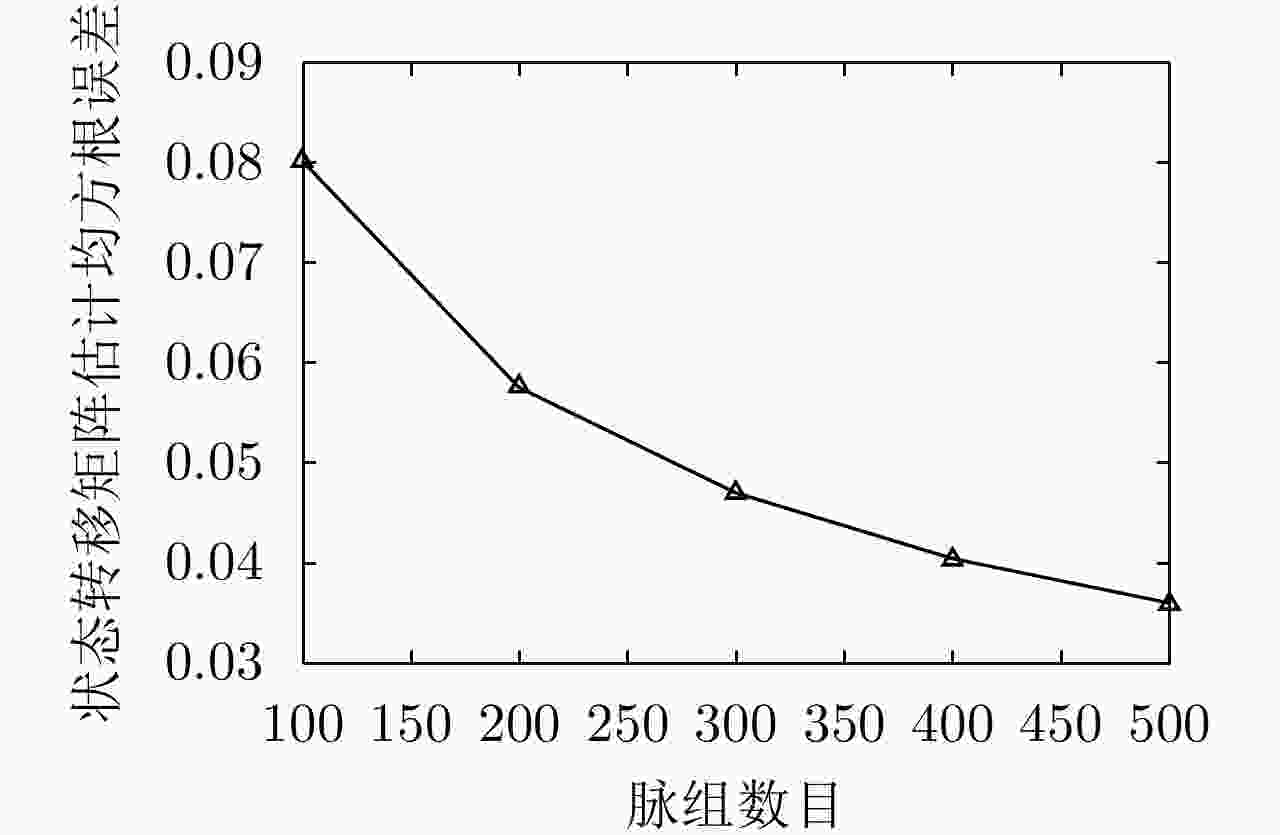-
摘要: 从电子侦察数据中反演多功能雷达的工作模式,是电子侦察领域广泛关注的难点问题,也是充分挖掘电磁大数据情报效益的重要内容,对雷达型号识别、工作状态识别、行为意图推断、精确电子干扰等应用具有直接的支撑作用。该文以多功能雷达信号模型的简洁性为基本依据,参考信息理论定义了雷达脉冲列的复杂度度量规则,并遵循复杂度最小化准则对多功能雷达脉冲列进行语义编码,以提取雷达执行不同功能时的脉组结构,进一步地,基于脉冲列编码序列估计脉组之间的切换矩阵,从而重建了多功能雷达工作模型。该文设置典型的仿真实验对新方法的可行性和性能进行了验证,结果表明新方法能够借助编码理论,自动从多功能雷达侦察脉冲列中准确提取雷达脉组,并高精度重建多功能雷达工作模型,脉冲列的语义编码与模型重建过程对漏脉冲等数据噪声具有较强的适应能力。Abstract: Retrieving the working modes of multifunction radar from electronic reconnaissance data is a difficult problem, and it has attracted widespread attention in the field of electronic reconnaissance. It is also an important task when extracting benefits from big electromagnetic data and provides straightforward support to applications, such as radar type recognition, working state recognition, radar intention inferring, and precise electronic jamming. Based on the assumption of model simplicity, this study defines a complexity measurement rule for multifunction radar pulse trains and introduces the semantic coding theory to analyze the temporal structure of multifunction radar pulse trains. The model complexity minimization criterion guides the semantic coding procedure to extract radar pulse groups corresponding to different radar functions from pulse trains. Furthermore, based on the coded sequence of the pulse train, the switching matrix between different pulse groups is estimated, and the hierarchical working model of multifunction radars is ultimately reconstructed. Simulations are conducted to verify the feasibility and performance of the new method. Simulation results indicate that the coding theory is successfully used in the proposed method to automatically extract pulse groups and rebuild operating models based on multifunction radar pulse trains. Moreover, the method is robust to data noises, such as missing pulses.
-
表 1 脉冲列迭代编码过程中顺次输出的脉组字典集
Table 1. Sequentially extracted pulse group dictionary set from pulse train during iterative coding process
迭代次数 脉组字典集 脉组 (µs) 频次 1 229.98 98 2 229.98, 330.00 98 3 229.98, 330.00, 430.00 98 4 229.98, 330.00, 430.00
284.9898
1095 229.98, 330.00, 430.00
355.97, 284.9898
1096 229.98, 330.00, 430.00
407.00, 355.97, 284.9898
1097 229.98, 330.00, 430.00
407.00, 355.97, 284.98
299.9898
109
938 229.98, 330.00, 430.00
407.00, 355.97, 284.98
299.98, 304.9998
109
939 229.98, 330.00, 430.00
407.00, 355.97, 284.98
299.98, 304.99, 310.0198
109
93表 2 脉组切换次数统计结果
Table 2. Switching number between different pulse groups
脉组1 脉组2 脉组3 脉组1 28 36 33 脉组2 44 18 31 脉组3 26 39 44 表 3 漏脉组率为50%条件下的脉组提取结果
Table 3. Extracted pulse groups from a pulse train with 50% pulse missing
脉组序号 脉组(µs) 频次 1 [230.02, 329.98, 429.98] 65 2 [230.02, 329.98] 52 3 [300.00, 304.93, 309.98] 46 4 [300.00, 304.93] 37 5 [407.03, 355.97, 284.97] 41 6 [407.03, 355.97] 59 -
[1] RICHARDS M A, SCHEER J A, and HOLM W A. Principles of Modern Radar: Basic Principles[M]. Raleigh: SciTech Publishing, 2010: 33–36. [2] 张光义, 赵玉洁. 相控阵雷达技术[M]. 北京: 电子工业出版社, 2006: 1–6.ZHANG Guangyi and ZHAO Yujie. Phased Array Radar Technology[M]. Beijing: Publishing House of Electronics Industry, 2006: 1–6. [3] MELVIN W L and SCHEER J A. Principles of Modern Radar: Radar Applications[M]. Edison: SciTech Publishing, 2014: 8–14. [4] WILEY R G. ELINT: The Interception and Analysis of Radar Signals[M]. Norwood: Artech House, 2006: 1–5. [5] VISNEVSKI N, KRISHNAMURTHY V, WANG A, et al. Syntactic modeling and signal processing of multifunction radars: A stochastic context-free grammar approach[J]. Proceedings of the IEEE, 2007, 95(5): 1000–1025. doi: 10.1109/JPROC.2007.893252 [6] VISNEVSKI N A. Syntactic modeling of multi-function radars[D]. [Ph. D. dissertation], McMaster University, 2005. [7] LIU Zhangmeng. Recognition of multifunction radars via hierarchically mining and exploiting pulse group patterns[J]. IEEE Transactions on Aerospace and Electronic Systems, 2020, 56(6): 4659–4672. doi: 10.1109/TAES.2020.2999163. [8] 方佳璐. 雷达信号工作模式识别研究[D]. [硕士论文], 浙江大学, 2017.FANG Jialu. Research of radar signal patter recognition[D]. [Master dissertation], Zhejiang University, 2017. [9] LI Yunjie, ZHU Mengtao, MA Yihao, et al. Work modes recognition and boundary identification of MFR pulse sequences with a hierarchical Seq2seq LSTM[J]. IET Radar, Sonar & Navigation, 2020, 14(9): 1343–1353. doi: 10.1049/iet-rsn.2020.0060 [10] 欧健. 多功能雷达行为辨识与预测技术研究[D]. [博士论文], 国防科技大学, 2017.OU Jian. Research on behavior recognition and prediction techniques against multi-function radar[D]. [Ph. D. dissertation], National University of Defense Technology, 2017. [11] OU Jian, CHEN Yongguang, ZHAO Feng, et al. Research on extension of hierarchical structure for multi-function radar signals[C]. 2017 Progress in Electromagnetics Research Symposium-Spring, St. Petersburg, Russia, 2017. [12] 林令民. 雷达语义结构分析算法设计与应用[D]. [硕士论文], 北京邮电大学, 2017.LIN Lingmin. Design and application of radar semantic structure analysis algorithm[D]. [Master dissertation], Beijing University of Posts and Telecommunications, 2017. [13] GRÜNWALD P D. The Minimum Description Length Principle[M]. Cambridge: MIT Press, 2007: 29–35. [14] SAYOOD K, 贾洪峰, 译. 数据压缩导论[M]. 4版. 北京: 人民邮电出版社, 2014: 5–8, 259–279.SAYOOD K, JIA Hongfeng, translation. Introduction on Data Compression[M]. 4th ed. Beijing: Posts & Telecom Press, 2014: 5–8, 259–279. [15] 傅祖芸. 信息论—基础理论与应用[M]. 4版. 北京: 电子工业出版社, 2015: 1–8.FU Zuyun. Information Theory—Principles and Application[M]. 4th ed. Beijing: Publishing House of Electronics Industry, 2015: 1–8. [16] ROSVALL M and BERGSTROM C T. Maps of random walks on complex networks reveal community structure[J]. Proceedings of the National Academy of Sciences of the United States of America, 2008, 105(4): 1118–1123. [17] ROSVALL M and BERGSTROM C T. Multilevel compression of random walks on networks reveals hierarchical organization in large integrated systems[J]. PLoS One, 2011, 6(4): e18209. doi: 10.1371/journal.pone.0018209 [18] TAN P N, STEINBACH M, KUMAR V, 范明, 范宏建, 译. 数据挖掘导论[M]. 2版. 北京: 人民邮电出版社, 2011: 27–38.TAN P N, STEINBACH M, KUMAR V, FAN Ming and FAN Hongjian, translation. Introduction to Data Mining[M]. 2nd ed. Beijing: Posts & Telecom Press, 2011: 27–38. [19] LIU Zhangmeng, KANG Shiqian, and CHAI Xianming. Automatic pulse repetition pattern reconstruction of conventional radars[J]. IET Radar, Sonar & Navigation, 2021, 15(5): 500–509. doi: 10.1049/rsn2.12053 [20] JAEGER H. Observable operator models for discrete stochastic time series[J]. Neural Computation, 2000, 12(6): 1371–1398. doi: 10.1162/089976600300015411 [21] JAEGER H, HAYKIN S, PRINCIPE J, SEJNOWSKI T, et al.. Learning Observable Operator Models Via the ES Algorithm[M]. New Directions in Statistical Signal Processing: From Systems to Brains. Cambridge: MIT Press, 2005. [22] BENGIO Y. Markovian models for sequential data[J]. Neural Computing Surveys, 1999, 2: 129–162. [23] RABINER L R. A tutorial on hidden Markov models and selected applications in speech recognition[J]. Proceedings of the IEEE, 1989, 77(2): 257–286. doi: 10.1109/5.18626 -



 作者中心
作者中心 专家审稿
专家审稿 责编办公
责编办公 编辑办公
编辑办公

 下载:
下载:









